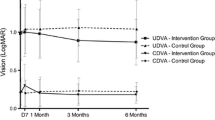Abstract
High success rates in clinical trials on keratoconic corneas suggest the possibility of efficient treatment against myopic progression. This study quantitatively investigated the in vitro ultrastructural effects of a photooxidative collagen cross-linking treatment with photosensitizer riboflavin and UVA light in human corneo-scleral collagen fibrils. A total of 30.8 × 2 mm corneo-scleral strips from donor tissue were sagittally dissected using a scalpel. The five analytic parameters namely fibril density, fibril area, corneo-scleral thickness, fibril diameter, and fibril arrangement were investigated before and after riboflavin–UVA-catalyzed collagen cross-linking treatment. Collagen cross-linking effects were measured at the corneo-scleral stroma and were based on clinical corneal cross-linking procedures. The structural response levels were assessed by histology, digital mechanical caliper measurement, scanning electron microscopy, and atomic force microscopy. Riboflavin–UVA-catalyzed collagen cross-linking treatment led to an increase in the area, density, and diameters of both corneal (110, 112, and 103 %) and scleral (133, 133, and 127 %) stromal collagens. It also led to increases in corneal (107 %) and scleral (105 %) thickness. Collagen cross-linking treatment through riboflavin-sensitized photoreaction may cause structural property changes in the collagen fibril network of the cornea and sclera due to stromal edema and interfibrillar spacing narrowing. These changes were particularly prominent in the sclera. This technique can be used to treat progressive keratoconus in the cornea as well as progressive myopia in the sclera. Long-term collagen cross-linking treatment of keratoconic and myopic progression dramatically improves weakened corneo-scleral tissues.




Similar content being viewed by others
References
Raiskup-Wolf F, Hoyer A, Spoerl E, Pillunat LE (2008) Collagen crosslinking with riboflavin and ultraviolet-A light in keratoconus: long-term results. J Cataract Refract Surg 34:796–801
McCall AS, Kraft S, Edelhauser HF, Kidder GW, Lundquist RR, Bradshaw HE, Dedeic Z, Dionne MJ, Clement EM, Conrad GW (2010) Mechanisms of corneal tissue cross-linking in response to treatment with topical riboflavin and long-wavelength ultraviolet radiation (UVA). Invest Ophthalmol Vis Sci 51:129–138
Gefen A, Shalom R, Elad D, Mandel Y (2009) Biomechanical analysis of the keratoconic cornea. J Mech Behav Biomed Mater 2:224–236
Agrawal V (2009) Corneal collagen cross-linking with riboflavin and ultraviolet-A light for keratoconus: results in Indian eyes. Indian J Ophthalmol 57:111–114
Vinciguerra P, Albè E, Trazza S, Rosetta P, Vinciguerra R, Seiler T, Epstein D (2009) Refractive, topographic, tomographic, and aberrometric analysis of keratoconic eyes undergoing corneal cross-linking. Ophthalmology 116:369–378
Kymionis GD, Diakonis VF, Kalyvianaki M, Portaliou D, Siganos C, Kozobolis VP, Pallikaris AI (2009) One-year follow-up of corneal confocal microscopy after corneal cross-linking in patients with post laser in situ keratosmileusis ectasia and keratoconus. Am J Ophthalmol 147:774–778
Wittig-Silva C, Whiting M, Lamoureux E, Lindsay RG, Sullivan LJ, Snibson GR (2008) A randomized controlled trial of corneal collagen cross-linking in progressive keratoconus: preliminary results. J Refract Surg 34:S720–S725
Wollensak G, Redl B (2008) Gel electrophoretic analysis of corneal collagen after photodynamic cross-linking treatment. Cornea 27:353–356
Al-Torbak AA, Al-Motowa S, Al-Assiri A, Al-Kharashi S, Al-Shahwan S, Al-Mezaine H, Teichmann K (2006) Deep anterior lamellar keratoplasty for keratoconus. Cornea 25:408–412
Spoerl E, Wollensak G, Seiler T (2004) Increased resistance of crosslinked cornea against enzymatic digestion. Curr Eye Res 29:35–40
Wollensak G, Iomdina E (2009) Long-term biomechanical properties of rabbit sclera after collagen crosslinking using riboflavin and ultraviolet A (UVA). Acta Ophthalmol 87:193–198
Wollensak G, Iomdina E, Dittert DD, Salamatina O, Stoltenburg G (2005) Cross-linking of scleral collagen in the rabbit using riboflavin and UVA. Acta Ophthalmol Scand 83:477–482
Wollensak G, Spoerl E (2004) Collagen crosslinking of human and porcine sclera. J Cataract Refract Surg 30:689–695
Siatkowski RM, Cotter SA, Crockett RS, Miller JM, Novack GD, Zadnik K (2008) Two-year multicenter, randomized, double-masked, placebo-controlled, parallel safety and efficacy study of 2 % pirenzepine ophthalmic gel in children with myopia. J AAPOS 12:332–339
Siatkowski RM, Cotter S, Miller JM, Scher CA, Crockett RS, Novack GD (2004) Safety and efficacy of 2 % pirenzepine ophthalmic gel in children with myopia: a 1-year, multicenter, double-masked, placebo-controlled parallel study. Arch Ophthalmol 122:1667–1674
Gwiazda J, Hyman L, Hussein M, Everett D, Norton TT, Kurtz D, Leske MC, Manny R, Marsh-Tootle W, Scheiman M (2003) A randomized clinical trial of progressive addition lenses versus single vision lenses on the progression of myopia in children. Invest Ophthalmol Vis Sci 44:1492–1500
Katz J, Schein OD, Levy B, Cruiscullo T, Saw SM, Rajan U, Chan TK, Yew Khoo C, Chew SJ (2003) A randomized trial of rigid gas permeable contact lenses to reduce progression of children's myopia. Am J Ophthalmol 136:82–90
Mao JR, Bristow J (2001) The Ehlers–Danlos syndrome: on beyond collagens. J Clin Invest 107:1063–1069
Bell GR (1993) Biomechanical considerations of high myopia: part I–physiological characteristics. J Am Optom Assoc 64:332–338
Choi S, Cheong Y, Lee HJ, Lee SJ, Jin KH, Park HK (2011) AFM study for morphological and material property of human sclera surface. J Nanosci Nanotechnol 11:6382–6388
Terry MA, Ousley PJ (2005) Deep lamellar endothelial keratoplasty? Visual acuity, astigmatism, in a large prospective series. Ophthalmology 112:1541–1548
Jung GB, Lee HJ, Kim JH, Lim JI, Choi S, Jin KH, Park HK (2011) Effect of cross-linking with riboflavin and ultraviolet A on the chemical bonds and ultrastructure of human sclera. J Biomed Opt 16:125004
Acknowledgments
This study was supported by a grant of the Korean Health Technology R&D Project, Ministry of Health & Welfare, Republic of Korea (A110216).
Author information
Authors and Affiliations
Corresponding author
Additional information
Samjin Choi and Seung-Chan Lee contributed equally to this paper.
Rights and permissions
About this article
Cite this article
Choi, S., Lee, SC., Lee, HJ. et al. Structural response of human corneal and scleral tissues to collagen cross-linking treatment with riboflavin and ultraviolet A light. Lasers Med Sci 28, 1289–1296 (2013). https://doi.org/10.1007/s10103-012-1237-6
Received:
Accepted:
Published:
Issue Date:
DOI: https://doi.org/10.1007/s10103-012-1237-6




